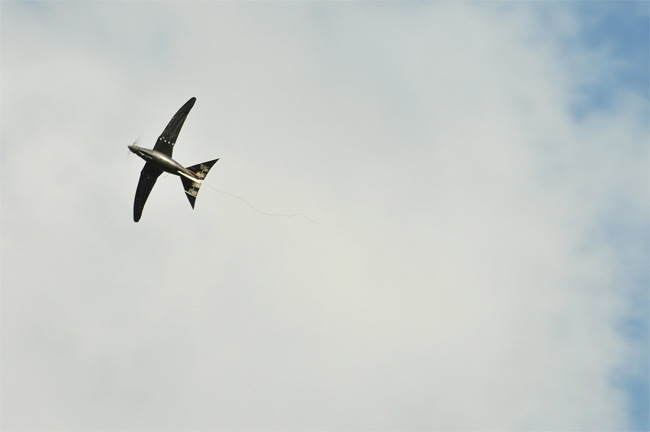Robotic Bird Makes First Flight

A micro-aircraft with feathered, morphing wings showed off its stuff yesterday when the bird-like craft lifted off for its first flight. And its landing was just as dramatic: The RoboSwift crashed into a tree.
"It first flew through a tree and landed in another; it crashed," said David Lentink of Wageningen University in the Netherlands, referring to a flight demonstration at the university, during which the craft flew for about five minutes at an altitude of some 650 yards (200 meters) under windy conditions.
The craft weighs less than three ounces (80 grams) and spans just 20 inches (51 centimeters) from wingtip to wingtip. Its small size and onboard cameras make RoboSwift a possible soaring spy: The craft could make scientific observations of wild birds without disturbing them or hover above crowds of people or vehicles for government and law enforcement surveillance purposes. In fact, the Dutch National Police Services Agency said it will financially support the craft's development.
Lentink and aerospace engineering students from Delft University of Technology in cooperation with Wageningen University designed the craft after the common swift, which can fly the equivalent of five roundtrips to the moon and remain airborne continuously for 4,350 miles (7,000 kilometers). Last year, Lentink and his colleagues discovered the common swift morphs its wings depending on flight conditions. The shape-shifting is what gives the bird its expert maneuverability and efficiency.
Like the bird, RoboSwift sports feathers, though just four on each wing. By folding these feathers over one another and sweeping them back and forth, the mini-craft morphs its wing shape and the surface area exposed to the elements in order to reduce drag. The feathery adjustments make RoboSwift a more efficient and agile flyer compared with fixed-wing craft.
"The new vehicle can really morph like a bird does. It uses actual feathers," Lentink said.
And during its demo, the robotic swift tested out its avian disguise with the real thing. "During the demonstration, there were a couple of gulls that flew toward [RoboSwift] to inspect it," Lentink told LiveScience.
Get the world’s most fascinating discoveries delivered straight to your inbox.
In the future, the craft will get lessons in bird-flying behaviors such as gliding. When gliding, the motor will be turned off and the propeller will fold up so the aircraft can fly even more quietly and save energy.
Next week, the students who developed RoboSwift will take part in an international contest in India for micro-aircraft called the American-Asian Micro Air Vehicle Competition.
- Video: How RoboSwift Works
- Many Mysteries of Flight Remain
Jeanna Bryner is managing editor of Scientific American. Previously she was editor in chief of Live Science and, prior to that, an editor at Scholastic's Science World magazine. Bryner has an English degree from Salisbury University, a master's degree in biogeochemistry and environmental sciences from the University of Maryland and a graduate science journalism degree from New York University. She has worked as a biologist in Florida, where she monitored wetlands and did field surveys for endangered species, including the gorgeous Florida Scrub Jay. She also received an ocean sciences journalism fellowship from the Woods Hole Oceanographic Institution. She is a firm believer that science is for everyone and that just about everything can be viewed through the lens of science.


